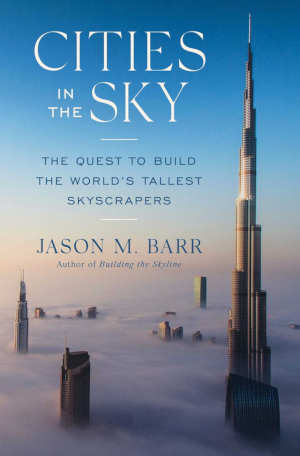Jason M. Barr Cities in the Sky recensie en informatie boek over The Quest to Build the World’s Tallest Skyscrapers. Op 14 mei 2024 verschijnt bij uitgeverij Scribner het Engelstalige boek over de economie van de hoogste flatgebouwen en wolkenkrabbers ter wereld. Hier lees je informatie over de inhoud van het boek, de schrijver en over de uitgave. Er is geen Nederlandse vertaling van het boek verkrijgbaar of aangekondigd.
Jason M. Barr Cities in the Sky recensie en review
Als er in de media een boekbespreking, review of recensie verschijnt van het boek Cities in teh Sky, The Quest to Build the World’s Tallest Skyscrapers, geschreven door Jason M. Barr, dan besteden we er op deze pagina aandacht aan.
- “With a global view and his eyes cast skyward, Barr provides an enjoyable, expansive study of a subject he loves.” (Kirkus Reviews)
Cities in the Sky
The Quest to Build the World’s Tallest Skyscrapers
- Auteur: Jason M. Barr (Verenigde Staten)
- Soort boek: economieboek, non-fictie
- Taal: Engels
- Uitgever: Scribner
- Verschijnt: 14 mei 2024
- Omvang: 384 pagina’s
- Uitgave: gebonden boek / ebook
- Prijs: $32.50 / $16.99
- Boek bestellen bij: Amazon / Bol / Libris
Flaptekst van het boek over de economie van de hoogste flatgebouwen ter wereld
From one of the world’s top experts on the economics of skyscrapers—a fascinating account of the ever-growing quest for super tall buildings across the globe.
The world’s skyscrapers have brought us awe and wonder, and yet they remain controversial—for their high costs, shadows, and overt grandiosity. But, decade by decade, they keep getting higher and higher. What is driving this global building spree of epic proportions? In Cities in the Sky, author Jason Barr explains all: why they appeal to cities and nations, how they get financed, why they succeed economically, and how they change a city’s skyline and enable the world’s greatest metropolises to thrive in the 21st century.
From the Empire State Building (1,250 feet) to the Shanghai Tower (2,073 feet) and everywhere in between, Barr explains the unique architectural and engineering efforts that led to the creation of each. Along the way, Barr visits and unpacks some surprising myths about the earliest skyscrapers and the growth of American skylines after World War II, which incorporated a new suite of technologies that spread to the rest of the world in the 1990s. Barr also explores why London banned skyscrapers at the end of the 19th century but then embraced them in the 21st and explains how Hong Kong created the densest cluster of skyscrapers on the planet. Also covered is the dramatic result of China’s “skyscraper fever” and then on to the Arabian Peninsula to see what drove Dubai to build the world’s tallest building, the Burj Khalifa, which at 2,717 feet, is higher than the new One World Trade Center in New York by three football fields.
Filled with fascinating details for urbanists, architecture buffs, and urban design enthusiasts alike, Cities in the Sky addresses the good, bad, and ugly for cities that have embraced vertical skylines and offers us a glimpse to the future to see whether cities around the world will continue their journey ever upwards.


